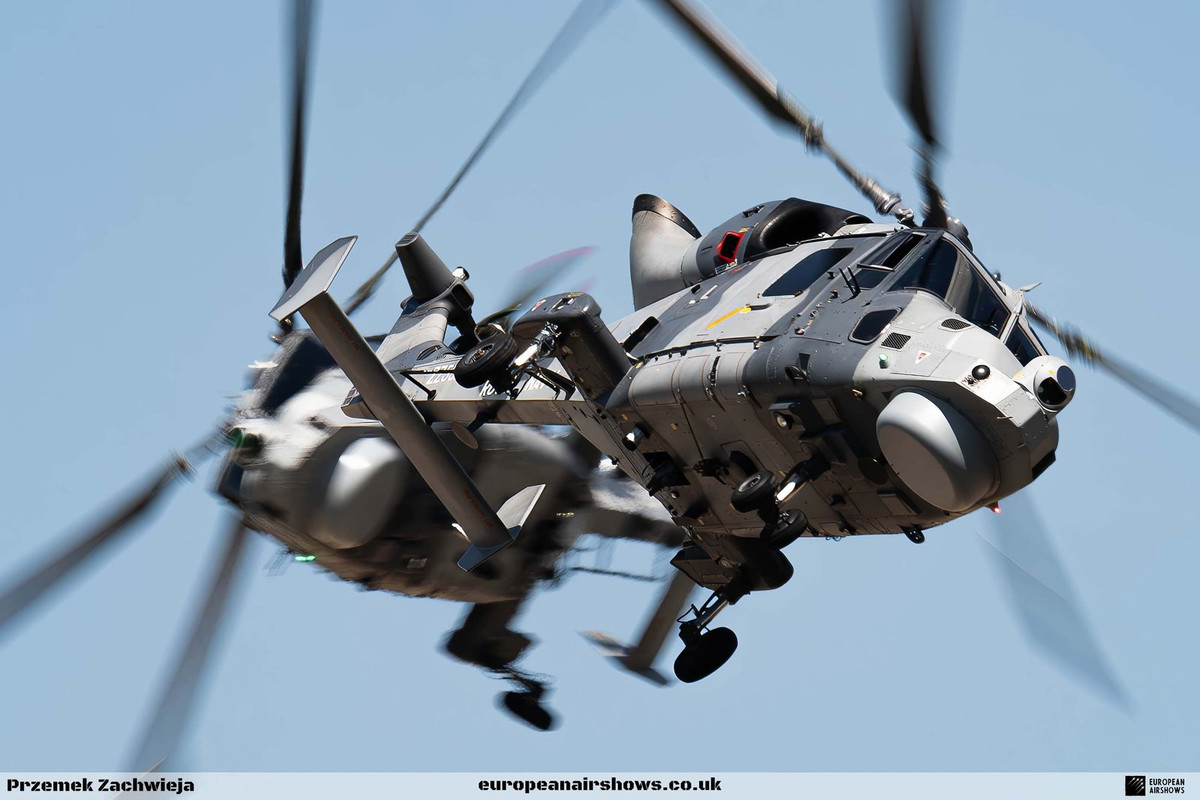
Black Cats Helicopter Display Team
Performer Information
The Black Cats are the Royal Navy’s premier helicopter display team, celebrated for their precision flying and captivating aerial performances. Comprising two AgustaWestland Wildcat HMA.2 anti-submarine warfare (ASW) and anti-surface warfare (ASuW) helicopters, the team showcases the Royal Navy’s aviation prowess at airshows and public events across the United Kingdom and Europe. Based at RNAS Yeovilton in Somerset, the Black Cats draw their aircraft and support from the 825 Naval Air Squadron.
The Black Cats were established in 2001, initially performing under the name “Lynx Pair.” The team utilized the navalised Westland Lynx HMA.8, a versatile military helicopter designed for both anti-submarine and anti-surface warfare roles. During their first three display seasons, the Lynx Pair gained recognition for their intricate close formation flying, opposition maneuvers, and synchronized aerial routines.
In 2004, the team adopted the “Black Cats” title, a name that would become synonymous with Royal Navy helicopter displays. This rebranding marked a significant evolution from their predecessors, “The Sharks,” who operated four red Westland Gazelle helicopters until their disbandment in 1992. Some of the Sharks’ display routines were incorporated into the Black Cats’ performances, ensuring a continuity of high-performance aerial displays within the Royal Navy.
The Lynx Pair achieved notable success early in their formation, winning ‘The Steedman Display Sword’ for the best United Kingdom participant at the Royal International Air Tattoo in 2003. Additionally, performing as “Les Chats Noirs,” the team showcased their skills at the French Navy’s 30th Anniversary of Lynx operations in Lanvéoc, Brittany. These accomplishments led to increased support from both the Royal Navy and AgustaWestland, facilitating the transition to the Black Cats identity and expanding their presence in international airshows.
During this period, the Black Cats solidified their reputation through consistent performances and innovative display routines, contributing to the Royal Navy’s public relations and esprit de corps. Their displays emphasized the versatility and advanced capabilities of naval helicopters, enhancing the visibility of the Fleet Air Arm’s operational roles.
In 2010, the Black Cats underwent significant organizational changes aimed at enhancing their display capabilities. The team expanded their display schedule to include fifteen airshows between May and October, incorporating both pairs and solo display routines. This expansion required meticulous planning and rigorous training to maintain the high standards expected of the Royal Navy’s display teams.
The following years saw the team maintaining a strong presence at national and international airshows, with official authorization and support from high-ranking naval officers ensuring the continuity of their performances. In 2012, the Black Cats continued to showcase their skills at thirteen venues, demonstrating adaptability and resilience in their display strategies.
In 2013, the Black Cats announced a strategic shift in their display approach, opting for a solo Westland Lynx HMA.8 display. This decision was driven by the aging Lynx airframes and the Royal Navy’s transition to the newer AgustaWestland Wildcat HMA.2, which offered enhanced capabilities and aligned better with current operational requirements. The solo display highlighted the aircraft’s maneuverability, providing audiences with a focused demonstration of the helicopter’s performance attributes.
By 2014, the Lynx HMA.8 was retired from the Black Cats’, marking the end of an era. From the 2015 season onwards, the team exclusively operated the AgustaWestland Wildcat HMA.2, reverting to a two-helicopter display format for the 2015 and 2016 seasons. This transition underscored the Royal Navy’s commitment to modernization and the integration of cutting-edge technology within its aviation assets.
In June 2015, the Black Cats were granted their Public Display Authority (PDA), formalizing their status as an official display team. Their inaugural public display with the Wildcat HMA.2 took place at the Biggin Hill Festival of Flight on 13 June 2015, marking a new chapter in their display history.
The Black Cats experienced a brief hiatus during the 2017 and 2018 display seasons, during which no official displays were conducted. However, the team made a comeback in 2019 with a single AgustaWestland Wildcat HMA.2, adapting to evolving operational requirements and resource allocations within the Royal Navy.
In early 2020, the Royal Navy introduced the “Wildcat Demo Team,” a solo display unit utilizing the Wildcat HMA.2. This initiative aimed to maintain the Royal Navy’s presence at airshows despite the challenges posed by transitioning to newer aircraft and shifting organizational priorities. However, the outbreak of the COVID-19 pandemic in March 2020 led to the suspension of all display activities, resulting in no Royal Navy helicopter displays for that year.
The Wildcat Demo Team resumed activities in 2021, authorized by senior naval leadership, and continued to perform at various prestigious events, including the British Grand Prix at Silverstone and international airshows in Belgium. In 2022 and 2023, the team maintained its solo display format.
In 2024, the Black Cats returned to a two-helicopter displays, the team also joined forces with the aircraft from the Navy Wings Historic Flight and perfromed special flypasts at selected events.
Specifications
Crew
2
Capacity
6 passengers
Length
15.24 m (50 ft 0 in)
Height
3.73 m (12 ft 3 in)
Max Speed
311 km/h (193 mph, 168 kn)
Range
777 km (483 mi, 420 nmi)
Service Ceiling
12,000 ft (3,657 m)
Endurance
2 hours and 15 minutes
About the Aircraft
The AgustaWestland AW159 Wildcat, previously known as the Future Lynx and Lynx Wildcat, is a modern military helicopter developed by the British-Italian manufacturer AgustaWestland, now marketed by the Italian aerospace company Leonardo. It is an advanced version of the Westland Super Lynx, designed to fulfill a variety of roles on the battlefield, including battlefield utility, search and rescue (SAR), aerial reconnaissance, anti-submarine warfare (ASW), anti-surface warfare (ASuW), utility operations, command and control, and troop transport.
The AW159 Wildcat features significant design enhancements with 95% new components, including a redesigned tail rotor and nose for improved durability and stealth. The airframe is marinised for naval operations, boasting a lifespan of 12,000 flight hours and a strengthened wheeled undercarriage for naval landings. Powered by two 1,362 hp LHTEC CTS800-4N turboshaft engines, the helicopter is equipped with BERP IV rotor blades and a new transmission system, increasing its maximum take-off weight by over one ton compared to the Super Lynx.
The avionics suite includes a glass cockpit with four multifunction displays, an integrated digital open systems architecture for enhanced ISTAR capabilities, and the Bowman communications system for secure data and voice transmission. The naval variant is additionally equipped with a Selex Galileo Seaspray 7000E AESA radar and an L-3 Wescam MX-15HDi electro-optical/infrared nose turret. The Wildcat can carry up to eight Future Anti-Surface Guided Weapons, including Martlet air-to-surface missiles and Sea Venom anti-ship missiles, and is capable of performing diverse missions such as aerial reconnaissance, ASW, ASuW, utility roles, fire control, command and control, and troop transport.
Manufactured by GKN Aerostructures, the airframe benefits from an 80% lower part count achieved through the use of monolithic machine components. The AW159 Wildcat is utilized in various service variants, including the Wildcat AH1 for the Army Air Corps and the Wildcat HMA2 for the Fleet Air Arm, and has been exported to the Republic of Korea Navy and the Philippine Navy.
Did You Know?
- The Black Cats are the Royal Navy’s official helicopter display team, showcasing their skills at airshows across the UK and Europe.
- The team originally performed under the name “Lynx Pair” before adopting the “Black Cats” title in 2004.
- The Black Cats display team was formed in 2001 and initially used the navalised version of the Westland Lynx helicopter.
- The team’s aircraft and crews are drawn from 825 Naval Air Squadron, based at RNAS Yeovilton in Somerset.
- Lieutenant Becky Frater was the first female pilot to lead the Royal Navy Black Cats display team in 2010.
Test Your Knowledge
1. In what year was the Black Cats display team formed?
Wildcat History
The development of the AgustaWestland AW159 Wildcat began in the early 2000s under the name Future Lynx, aiming to replace the existing Lynx helicopters operated by both the Royal Navy and British Army. Initial studies in 2002 led to the Surface Combatant Maritime Rotorcraft (SCMR) and Battlefield Light Utility Helicopter (BLUH) programs. In July 2002, AgustaWestland partnered with Thales Group to develop the helicopter’s core avionics, securing additional funding from the Ministry of Defence (MOD).
By 2004, it was determined that upgrading the existing Lynx models was uneconomical, prompting a shift to developing a new airframe. The National Audit Office’s criticism of the UK’s helicopter fleet in late 2004 led to a major restructuring of the MOD’s procurement processes, resulting in the renaming of the BLUH program to Battlefield Reconnaissance Helicopter (BRH) with reduced utility transport requirements. In 2005, the MOD selected the Future Lynx as the preferred option, awarding AgustaWestland a £1 billion contract in June 2006 for 70 helicopters under the Strategic Partnering Arrangement.
The manufacturing phase commenced in October 2007, and by September 2008, the selected LHTEC CTS800-4N powerplant received EASA certification. The first airframe was delivered by GKN in November 2008. The Future Lynx was officially designated as the AW159 and named Wildcat in April 2009, with its maiden flight taking place on November 12, 2009. Entry into service began in August 2014 for the Army Air Corps and early 2015 for the Fleet Air Arm, leading to the retirement of the last Lynx helicopters within five years.
Further developments included the addition of Wildcat Light Assault Helicopters for British special forces and export orders from international customers. The program experienced cost increases and continued to integrate advanced weapon systems, solidifying the AW159 Wildcat as a key component of modern military rotary-wing operations.






























